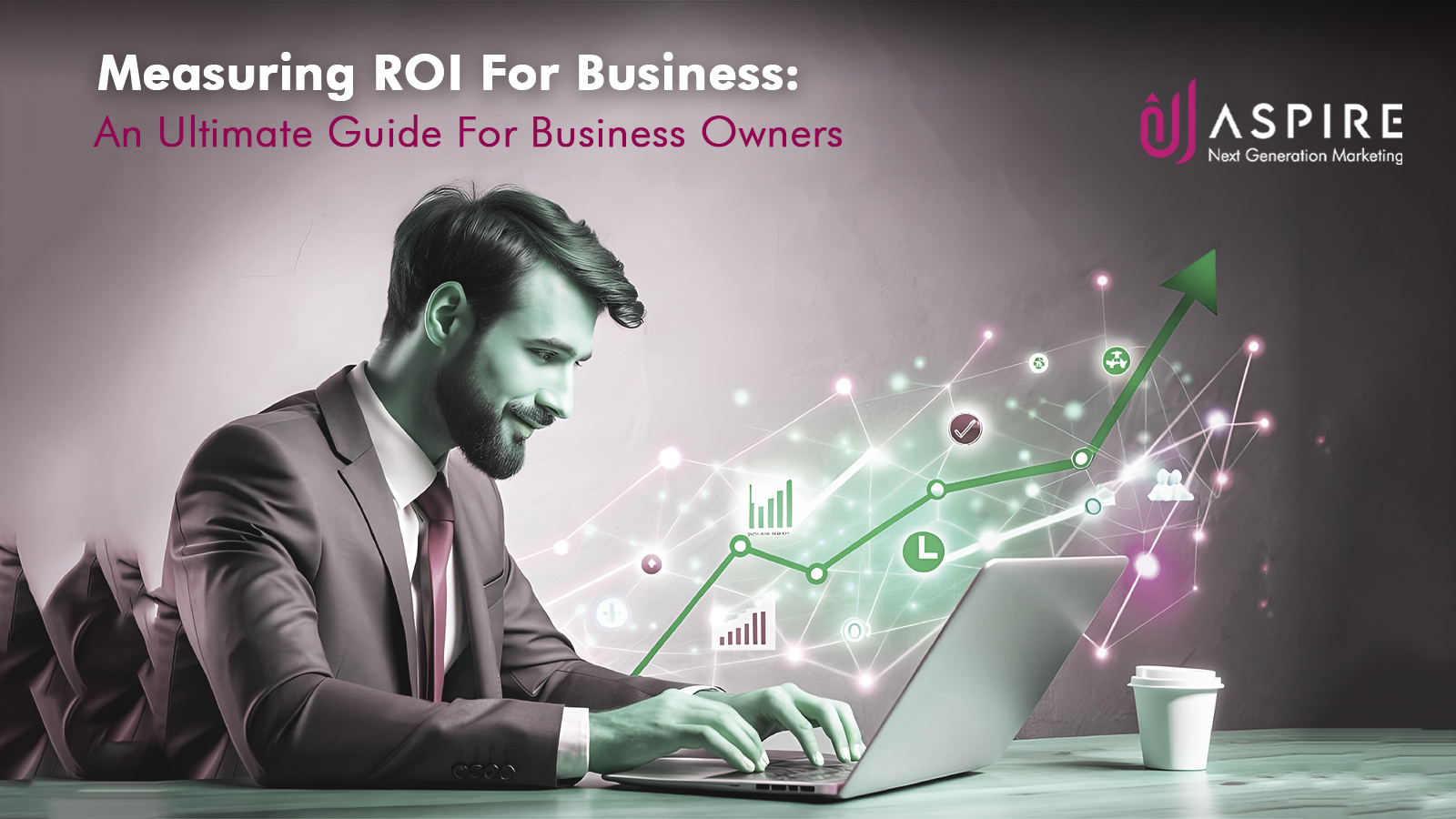There is no question that you need to invest in your business, but firstly, you have to understand that whether those investments are going to bring any return on investment can be incredibly difficult. If you are an entrepreneur and want to check accuracy and finance Return on Investment properly, there is no escape from it. This post is a comprehensive reference to what exactly ROI is for business, breaking down the basics of formulas and ways results are calculated, as well as different types of return on investment. We will also offer some tips on how you can make sure that your investments are successful. Aspire Digital Media can help with their state-of-the-art knowledge & equipment in marketing!
Table of Contents
WHAT IS ROI?
Return on Investment—a typical financial metric used to evaluate the profitability of an investment based on its cost. Return on Investment for business–the amount by which investment returns exceed costs. Since it is simple and easy to apply across industries, you can use this metric with literally any labor of something investible (from marketing campaigns to operational efficiency improvements or whatever else).
Aspire Digital Media is known for its pathbreaking marketing solutions that are considered the pioneer in ROI for business optimization. They bring to businesses high-end strategic plans and an overwhelming prospective plan on every investment you are willing to make with what they aim for expansion. We come with experience across marketing techniques and data-driven insights to deliver higher ROI production and meaningful business results. In conclusion, having a grip on Return on Investment is the turning point in your real strategy investment or how profitable you will be.

Why ROI Matters
Return on Investment is an important metric for several reasons:
- Assessment: Return on Investment for business will help you determine how well your investments are performing. It gives you an accurate picture of whether your spending is performing as expected.
- Budget allocation: Knowing your ROI for business enables you to assign funds more wisely. You can prioritize and cut down on areas that do not deliver much value, which in return allows you to spend it where the focus is.
- Strategic Decisions: Return on Investment for business gives you insights into making better strategic decisions. This makes it easier to then select investments that are in line with your business goals and offer the greatest returns.
- Goal Setting: By knowing the ROI for your business, we can set more realistic goals and benchmarks based on previous performance and expected returns.
- Control: it guarantees that everything you are investing in pays off for your business.
This provides accountability in the form of being able to point out exactly which dollars spent result directly in the success and can help justify marketing expenses or operational costs when presenting it back upstream.
Why Return on Investment (ROI) is an important metric:
- Performance Evaluation: Return on Investment gives your business grade which means telling how your investments have performed. It provides you with a vision of whether your expenses are actionable or not.
- Budget Allocations: Know your Return on Investment for business and plan the resource allocations better with proper budget management. This enables you to focus on high-Return on Investment or low-return activities.
- Strategic: It uses data to understand the decisions you make. You can look for the same to better understand what investment would cater to you with a matching return in compliance with your motives.
- Setting goals: Again, the measurement of ROI back to goals will allow you to set realistic targets and benchmarks as well; using historical performance (for past-human touch) or expectations for future returns.
- Accountability: The Return on Investment for your business will have to be measured, which means that every dollar spent is matched up with adding value to your business’s success.
STEP-BY-STEP ROI CALCULATION
Net Profit: If you want to find your net profit, simply subtract the costs from your revenue. If this is clear let me give you an example, so say if you spent ₹1,60,000 in a digital marketing campaign and earned ₹4,80, the Net Profit would now be:

Net Profit (₹4,80,000) — Investment Cost (₹1,60,000 ) = ₹3,20,000.
Investment Cost: This is the complete cost of the transaction you paid to invest money
EX: ₹1,60,000 in this case.
ROI=Net profit/investment costX100 %
ROI Example: 2X ROI = ₹3,20,000 / ₹1,60,000
This gives ROI as 2 i.e. ROI = Returns / Investment or the percentage return you’ve got on your investment (Represented in whole number) ×100 %.
200% ROI implies you got ₹2 for every rupee invested, effectively doubling your value.
TYPES OF ROI
Return on Investment for business can be categorized into various types based on the investment focus:
- Marketing ROI: Returns measure on business and individual marketing campaigns or channels. It tells you how well your marketing strategies are working.
- Operational ROI: This measures how efficient operational processes are and what impacts the profitability of a business. This measures the return from deploying instruments and more economical technologies that reduce operation costs.
- Financial ROI: Looks at the broader financial impact of investments, including revenue growth and profit margins.
- Customer ROI: Measures the value gained from acquiring and retaining customers. It includes evaluating customer lifetime value and acquisition costs.
- Social Media ROI: Focuses on the return from social media activities, including engagement rates and conversions attributed to social media efforts.
Tips for Success
Read & Learn about the tips for a higher Return on Investment, and successful investments.

- Establish clear, measurable goals define clear investment objectives that are specific and measurable, to make it easier for you to track progress and assess the success of your actions.
- Utilize data analytics to gain insights optimize strategies and drive better Return on Investment to arrive at decisions that are based on information.
- Optimize campaigns so that Constantly test new techniques to reduce your investment. Analyzing the data and adjusting tactics accordingly can yield better results.
- Keep an eye on key performance indicators that are pertinent to what you want. Set a regular review. Conversion rates and CPC are important KPIs to measure your Return on Investment for business.
- Customer feedback enhances and gives an insight into customer preferences and pain areas for investment or strategies.
- Do not neglect costs, ensure they are carefully monitored and the relevant costs of your investment are factored in so you do not have skewed ROI calculations.
- Quality over volume demonstrates a preference for high-quality investments and approaches. High quality typically yields a higher Return on Investment than is provided by a generic or lower-quality approach.
- Learn from your past investments (good and bad). Take this data and improve your future Return on Investment! For your business, remember to stay current on what is happening with our strategies and related improvements.
- Seek expert advice to gain consultations with experts like Aspire Digital Media to get actionable tips and tricks to boost your Return on Investment for business.
CONCLUSION
Return on Investment for business is not just a financial element; it operates as an invaluable tool to steer your business in a smarter and more profitable direction. When you know what Return on Investment is, why it matters, and how to calculate it regularly, can make sure that every dollar spent by your business helps grow its profit. With ROI, you can measure the success of marketing campaigns and make strategic decisions based on data to use resources efficiently.
Aspire Digital Media, the next-generation marketing expert, with their perspective, tools, and analytics creates clarity about your investments and helps you get the most out of them commercially while easing analyzing environmental risks. Adopt these tactics, be diligent with your ROI tracking (you still are measuring everything, right?), and see.
Read more: The Future of Marketing: Why Virtual Reality (VR) is Leading the Charge
FAQ
What Makes a Good ROI in Business?
A healthy return on investment in business is usually considered to be around 10 -15%, but this number can vary depending upon the industry and specific goals of that particular business. The perfect ROI should fit your growth and profitability targets.
How much ROI is profitable?
Therefore, any ROI greater than 0% is considered profit on your investment. and assert equality with opacity. However, the standard goal is a profit margin of 10%, and other goals are needed for long-term viability to meet your business objectives.
What is an ROI calculator?
An ROI calculator is used to gauge the profitability of investments, by calculating how long before profits pay for such an opportunity. These insights help in understanding the financial return for different products or decisions of business and thus contribute to strategic planning.


Add a Comment